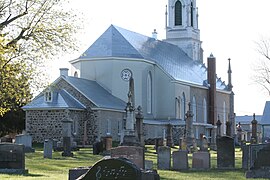Batiscan, Quebec
Batiscan | |
|---|---|
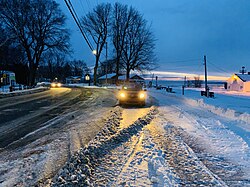 Principale Street, Chemin du Roy, Road 138 | |
| Motto: "Do Well What You Do" | |
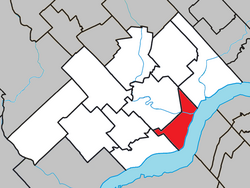 Location within Les Chenaux RCM. | |
| Coordinates: 46°30′N 72°15′W / 46.500°N 72.250°W[1] | |
| Country | |
| Province | |
| Region | Mauricie |
| RCM | Les Chenaux |
| Settled | 1666 |
| Constituted | July 1, 1855 |
| Government | |
| • Mayor | Christian Fortin |
| • Federal riding | Saint-Maurice—Champlain |
| • Prov. riding | Champlain |
| Area | |
• Total | 58.90 km2 (22.74 sq mi) |
| • Land | 42.95 km2 (16.58 sq mi) |
| Population (2011)[3] | |
• Total | 940 |
| • Density | 21.9/km2 (57/sq mi) |
| • Pop 2006-2011 | |
| • Dwellings | 510 |
| Time zone | UTC−5 (EST) |
| • Summer (DST) | UTC−4 (EDT) |
| Postal code(s) | |
| Area codes | 418 and 581 |
| Highways | |
| GNBC Code | ELIDL |
| NTS Map | 031I08 |
| Website | www |
Batiscan is a municipality in the Mauricie region of the province of Quebec in Canada. It is located along the St Lawrence River at the mouth of the Batiscan River.
The usage includes Batiscan in Batiscanie, the common name for the region.[4]
Geography
[edit]The community of Batiscan is located on the north shore of the St. Lawrence River. Part of its territory drains directly into the St. Lawrence River. The territory of the Lordship of Batiscan is part of the major units of relief that structure the Quebec space.
To the interior lies the fairly flat plain of the St. Lawrence Lowlands. This plain was covered by glacial sediments during the Last Glacial Period (Pleistocene) and by marine and fluvial deposits (clay/sand) with the invasion of the Champlain Sea. This flat landform unit was used for the first settlements in Batiscanie. Up to the foothills of the Laurentians, the place offers: proximity to the rivers, smooth terrain and fertile soils.
The Batiscan territory is linked to "the continental climate with cold winters" where a long, harsh and snowy winter dominates. From November to April, snow covers the ground and the waterways are frozen. In 1661, Pierre Boucher (1622-1717), French explorer and Governor of New France, wrote to King Louis XIV of France: The severity of winter forced the pioner on the shores of the St. Lawrence, "to hide in his home (chaumière)".[4]
History
[edit]In 1609, Samuel de Champlain, on his way to Lake Champlain, wrote of a Huron and Algonquin encampment one and a half leagues from St. Mary's River, which places it around the modern settlement of Batiscan. A year later, he wrote of having met an indigenous leader called "Batiscan". On his map of 1612, Champlain designated this area north of the Saint Lawrence River as the "region of bastisquan". While the name has virtually remained unchanged since first mentioned by Champlain, its meaning has remained uncertain, possibly meaning mist or haze (as often seen at the mouth of the Batiscan River), pulverized dried meat, rushes, or even making a mistake, taking a misstep.[1]
In 1636, the Madeleine Seignory was granted to Jacques Laferté, and included all the territory between the Chevrotière and Saint-Maurice Rivers, until 100 kilometers inland from the Saint Lawrence River. Subsequently, the seignory was divided into several smaller estates or fiefs, including the Batiscan Fiefdom that on March 13, 1639, was given to the Jesuits to accommodate the evangelization and the settlement of Indian tribes living there. This territory corresponded approximately to the current municipalities of Batiscan and Saint-Geneviève-de-Batiscan.[5]
The actual colonization of the area began in 1666, and it developed according to the seigneurial system of New France. The land granted to each settler was typically a long narrow rectangle with a proportion of about 1 to 10, that would allow each settler access to the river and the road. By 1709, all land bordering the Saint Lawrence River was occupied and a second row was equally divided inland. Over time, the territory of Batiscan grew to have 3 rows south-west of the Batiscan River and 2 rows north-east of it.[5]
Settlers would cultivate a portion of their land, but because of outdated farming techniques, isolation from markets, and lack of roads, agriculture remained a challenge. But with the Batiscan River providing access to the interior and the trading post at Trois-Rivières providing market access, people from Batiscan turned to trapping for survival. Logging also provided opportunities and several sawmills appeared along the rivers flowing through the area.[5]
On November 2, 1684, the Parish of Saint-François-Xavier-de-Batiscan was formed, named by the Jesuits after one of the co-founders of their order, Francis Xavier. The community itself developed as a linear village, stretching along the Chemin du Roy and without any real village centre, exceeding even the administrative boundaries of cadastral parishes. By the end of the French Era, the towns of Champlain, Batiscan, and Sainte-Anne-de-la-Pérade were all connected by a long ribbon of buildings.[5]
After 1712, Batiscan was one of the places in which French settlers enslaved Fox Indians of Wisconsin.[6]
In 1845, the Parish Municipality of Saint-François-Xavier-de-Batiscan was formed. It was abolished a few years later but reestablished on July 1, 1855.[1]
The industrial revolution led to economic development and a small port on the river and the railroad were built. At the Batiscan station, a new small village centre grew. But the economic crisis of 1929 broke the momentum of the Station Village and gradually agriculture reclaimed primary place in the landscape and economy of Batiscan, with commercial and industrial activities remaining marginal.[5]
Because of its proximity to the regional hub of Trois-Rivières, the growing use of cars, and the improved road network, Batiscan is becoming a suburban community, leading to increased urbanization of the Saint Lawrence shore.[5]
In 1986, the Parish Municipality of Saint-François-Xavier-de-Batiscan became the Municipality of Batiscan. On December 31, 2001, it was transferred from the Francheville Regional County to the new Les Chenaux Regional County, following the creation of the new City of Trois-Rivières and the dissolution of the Francheville RCM.[1]
The Geographical Evolution of Colonization. Because of its early and intensive development, Batiscan was already the largest Lordship in the Trois-Rivières area by the end of the seventeenth century. The shores of the St. Lawrence River were already occupied, pioneers were moving inland along the Batiscan River.[7]
Demographics
[edit]Population trend:[8]
- Population in 2011: 940 (2006 to 2011 population change: -0.9%)
- Population in 2006: 949
- Population in 2001: 905
- Population in 1996: 891
- Population in 1991: 869
Private dwellings occupied by usual residents: 443 (total dwellings: 510)
Mother tongue:
- English as first language: 0%
- French as first language: 94.1%
- English and French as first language: 0%
- Other as first language: 5.9%
Photos
[edit]St Lawrence River
- Warf, boat launch, parking lot, beach
-
Parking, Hangar de Batiscan,[9] public warf
-
Wharf, boat launch, Principale Street
-
Information panel
-
Boat launch, commercial fishermen
-
Beach, wharf stonework, fisherwoman
-
Batiscan River's mouth
-
Sandy beach
Flore
- Ditches, road edges, wasteland
-
Iris versicolor L. — Larger blue-flag
-
Lilium tigrinum (Syn. lancifolium) Ker-Gawler. — Tiger lily
-
Rhus radicans L. (syn. Toxicodendron radicans (L.) Kuntze) ― Poison ivy
-
Lilium canadense L. — Wild yellow lily
-
Sedum acre (L.) Link. — Wall pepper
Built heritage
-
Heritage site of the Old Presbytery of Batiscan,[10] maybe 1926
-
Heritage site Vieux-Presbytère-de-Batiscan
-
Saint-François-Xavier-de-Batiscan church, cemetery
-
Batiscan River, old iron bridge on Chemin du Roy
-
Principale street, Road 138, Chemin du Roy
- Main Street - Route 138
-
Batiscan River, old iron bridge
-
St. Lawrence River, Route 138 West, Batiscan, from the municipal wharf
-
Main Street - Chemin du Roy
-
Agricultural area
-
Agricultural area
See also
[edit]References
[edit]- ^ a b c d "Batiscan (Municipalité)" (in French). Commission de toponymie du Québec. Retrieved 2010-02-17.
- ^ a b "Répertoire des municipalités: Geographic code 37210". www.mamh.gouv.qc.ca (in French). Ministère des Affaires municipales et de l'Habitation.
- ^ a b "Batiscan, Quebec (Code 2437210) Census Profile". 2011 census. Government of Canada - Statistics Canada.
- ^ a b Jean-Philippe Marchand. "The Colonization of the Lordship of Batiscan in the 17th and 18th Centuries: Space and People" (PDF). Érudit an inter-university consortium (in English and French). Master's thesis, Université du Québec à Chicoutimi. pp. 4, 16 of 162. Retrieved 2023-12-05.
The most important stronghold of the government of Trois-Rivières, during the French Regime
- ^ a b c d e f "Histoire de Batiscan" (in French). Municipalité de Batiscan. Retrieved 2010-02-17.
- ^ Rushforth, Brett (1 January 2006). "Slavery, the Fox Wars, and the Limits of Alliance". William and Mary Quarterly. 63 (1): 66. doi:10.2307/3491725. JSTOR 3491725. Retrieved 7 April 2022.
- ^ Jarnoux, Phllipe (1986). "La colonisation de la seigneurie de Batiscan aux 17e et 18e siècles : l'espace et les hommes" (PDF) (in English and French). Institut d'histoire de l'Amérique française. p. 30. Retrieved 2023-11-18.
This article examines the settlement of the Lordship of Batiscan, the largest fief in the government of Trois-Rivières during the French Regime
- ^ Statistics Canada: 1996, 2001, 2006, 2011 census
- ^ Corporation touristique de Batiscan, Raymond Rivard président. "Hangar de Batiscan". Retrieved 13 May 2023.
- ^ Site historique. "Vieux presbytère de Batiscan". Retrieved 13 May 2023.
External links
[edit] Media related to Batiscan, Quebec at Wikimedia Commons
Media related to Batiscan, Quebec at Wikimedia Commons
Historical publications
[edit]- La seigneurie de Batiscan - Chronique des premières années (1636-1681), Éditions du Bien public, written by Raymond Douville, collection "La Seigneurie de Batiscan", cahier no. 1, published by the local historical society "Batiscan et son histoire".(in French)
- Batiscan s'érige - Prémices paroissiales 1670-1708, Éditions du Bien public, written by Jean-Paul Foley, collection "La Seigneurie de Batiscan", cahier no. 2, published by the local historical committee "Batiscan et son histoire".(in French)
- Répertoire des naissances de Batiscan (St-François-Xavier) - 1682-1989, written by Jean-Paul Foley, collection "Batiscan et son histoire", 1990, 237 pages.(in French)
- Répertoire des mariages de Batiscan (St-François-Xavier), written by Réjeanne Bouchard, collection "Batiscan et son histsoire", 1982.(in French)
- 'Répertoire des mariages de Batiscan (St-François-Xavier) 1682-1900, compiled by Dominique Campagna, 1971, 83 pages. (in French) (sold out edition).
- Répertoire des sépultures de Batiscan (St-François-Xavier) 1682-1995, written by Jean-Paul Foley, collection "Batiscan et son histoire", 1996, 109 pages.(in French)


![Parking, Hangar de Batiscan,[9] public warf](http://upload.wikimedia.org/wikipedia/commons/thumb/7/7f/Batiscan-QC-Quai_public_en_aval_du_village-2018-09-29.jpg/371px-Batiscan-QC-Quai_public_en_aval_du_village-2018-09-29.jpg)



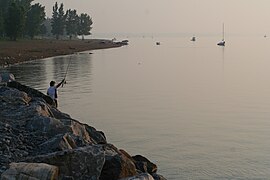



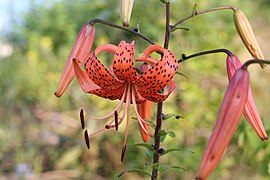



![Heritage site of the Old Presbytery of Batiscan,[10] maybe 1926](http://upload.wikimedia.org/wikipedia/commons/thumb/a/ac/Vieux_presbytere_de_Batiscan_restaure_01.jpg/252px-Vieux_presbytere_de_Batiscan_restaure_01.jpg)

